2012 TOYOTA YARIS HYBRID ECO mode
[x] Cancel search: ECO modePage 476 of 704
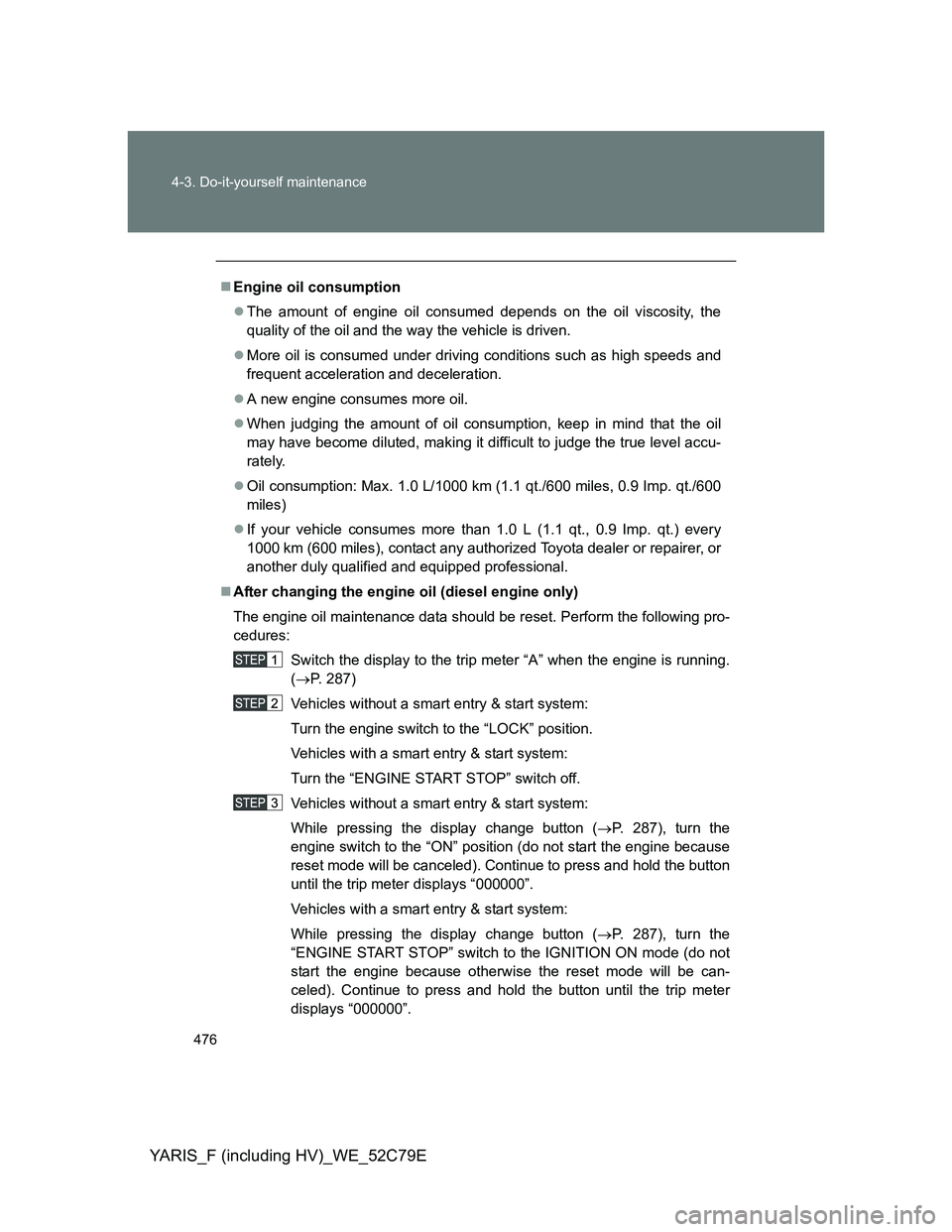
476 4-3. Do-it-yourself maintenance
YARIS_F (including HV)_WE_52C79E
Engine oil consumption
The amount of engine oil consumed depends on the oil viscosity, the
quality of the oil and the way the vehicle is driven.
More oil is consumed under driving conditions such as high speeds and
frequent acceleration and deceleration.
A new engine consumes more oil.
When judging the amount of oil consumption, keep in mind that the oil
may have become diluted, making it difficult to judge the true level accu-
rately.
Oil consumption: Max. 1.0 L/1000 km (1.1 qt./600 miles, 0.9 Imp. qt./600
miles)
If your vehicle consumes more than 1.0 L (1.1 qt., 0.9 Imp. qt.) every
1000 km (600 miles), contact any authorized Toyota dealer or repairer, or
another duly qualified and equipped professional.
After changing the engine oil (diesel engine only)
The engine oil maintenance data should be reset. Perform the following pro-
cedures:
Switch the display to the trip meter “A” when the engine is running.
(P. 287)
Vehicles without a smart entry & start system:
Turn the engine switch to the “LOCK” position.
Vehicles with a smart entry & start system:
Turn the “ENGINE START STOP” switch off.
Vehicles without a smart entry & start system:
While pressing the display change button (P. 287), turn the
engine switch to the “ON” position (do not start the engine because
reset mode will be canceled). Continue to press and hold the button
until the trip meter displays “000000”.
Vehicles with a smart entry & start system:
While pressing the display change button (P. 287), turn the
“ENGINE START STOP” switch to the IGNITION ON mode (do not
start the engine because otherwise the reset mode will be can-
celed). Continue to press and hold the button until the trip meter
displays “000000”.
Page 483 of 704

483 4-3. Do-it-yourself maintenance
4
Maintenance and care
YARIS_F (including HV)_WE_52C79E
Before recharging
When recharging, the battery produces hydrogen gas which is flammable
and explosive. Therefore, observe the following before recharging:
If recharging with the battery installed on the vehicle, be sure to discon-
nect the ground cable.
Make sure the power switch on the charger is off when connecting and
disconnecting the charger cables to the battery.
After recharging/reconnecting the battery (vehicles with a smart entry
& start system)
Unlocking the doors using the smart entry & start system may not be
possible immediately after reconnecting the battery. If this happens, use
the wireless remote control or the mechanical key to lock/unlock the
doors.
Start the engine with the “ENGINE START STOP” switch in ACCES-
SORY mode. The engine may not start with the “ENGINE START STOP”
switch turned off. However, the engine will operate normally from the sec-
ond attempt.
The “ENGINE START STOP” switch mode is recorded by the vehicle. If
the battery is reconnected, the vehicle will return the “ENGINE START
STOP” switch mode to the status it was in before the battery was discon-
nected. Make sure to turn off the engine before disconnect the battery.
Take extra care when connecting the battery if the “ENGINE START
STOP” switch mode prior to discharge is unknown.
If the engine will not start even after multiple attempts, contact any autho-
rized Toyota dealer or repairer, or another duly qualified and equipped pro-
fessional.
Page 491 of 704

491 4-3. Do-it-yourself maintenance
4
Maintenance and care
YARIS_F (including HV)_WE_52C79E
Before recharging
When recharging, the 12-volt battery produces hydrogen gas which is flam-
mable and explosive. Therefore, observe the following precautions before
recharging:
If recharging with the 12-volt battery installed on the vehicle, be sure to
disconnect the ground cable.
Make sure the power switch on the charger is off when connecting and
disconnecting the charger cables to the 12-volt battery.
When disconnecting the 12-volt battery terminals
Always disconnect the negative (-) terminal first.
After recharging/reconnecting the 12-volt battery
Unlocking the doors using the smart entry & start system may not be
possible immediately after reconnecting the 12-volt battery. If this hap-
pens, use the wireless remote control or the mechanical key to lock/
unlock the doors.
Vehicles with an electronic key: Start the hybrid system with the
“POWER” switch in ACCESSORY mode. The hybrid system may not
start with the “POWER” switch turned off. However, the hybrid system will
operate normally from the second attempt.
Caution symbols
The meanings of each caution symbol on the top of the battery are
as follows:
No smoking, no naked
flames, no sparksBattery acid
Shield eyesNote operating
instructions
Keep away from childrenExplosive gas
Page 492 of 704

492 4-3. Do-it-yourself maintenance
YARIS_F (including HV)_WE_52C79E
Vehicles with an electronic key: The “POWER” switch mode is recorded
by the vehicle. If the 12-volt battery is reconnected, the vehicle will return
the “POWER” switch mode to the status it was in before the 12-volt bat-
tery was disconnected. Make sure to turn off the power before discon-
nect the 12-volt battery. Take extra care when connecting the 12-volt
battery if the “POWER” switch mode prior to discharge is unknown.
If the system will not start even after multiple attempts, contact any autho-
rized Toyota dealer or repairer, or another duly qualified and equipped pro-
fessional.
CAUTION
Chemicals in the 12-volt battery
The 12-volt battery contains poisonous and corrosive sulfuric acid and may
produce hydrogen gas which is flammable and explosive. To reduce the risk
of death or serious injury, take the following precautions while working on or
near the 12-volt battery:
Do not cause sparks by touching the 12-volt battery terminals with tools.
Do not smoke or light a match near the 12-volt battery.
Avoid contact with eyes, skin and clothes.
Never inhale or swallow electrolyte.
Wear protective safety glasses when working near the 12-volt battery.
Keep children away from 12-volt battery.
Where to safely charge the 12-volt battery
Always charge the 12-volt battery in an open area. Do not charge the 12-volt
battery in a garage or closed room where there is insufficient ventilation.
When disconnecting the 12-volt battery terminals
Always disconnect the negative (-) terminal first. If the positive (+) terminal is
disconnected first and touches a surrounding metal surface sparks will be
produced, possibly starting a fire. It could also result in an electric shock or
serious injury.
How to recharge the 12-volt battery
Only perform a slow charge (3.5 A or less). The 12-volt battery may explode
if charged at a quicker rate.
Page 496 of 704
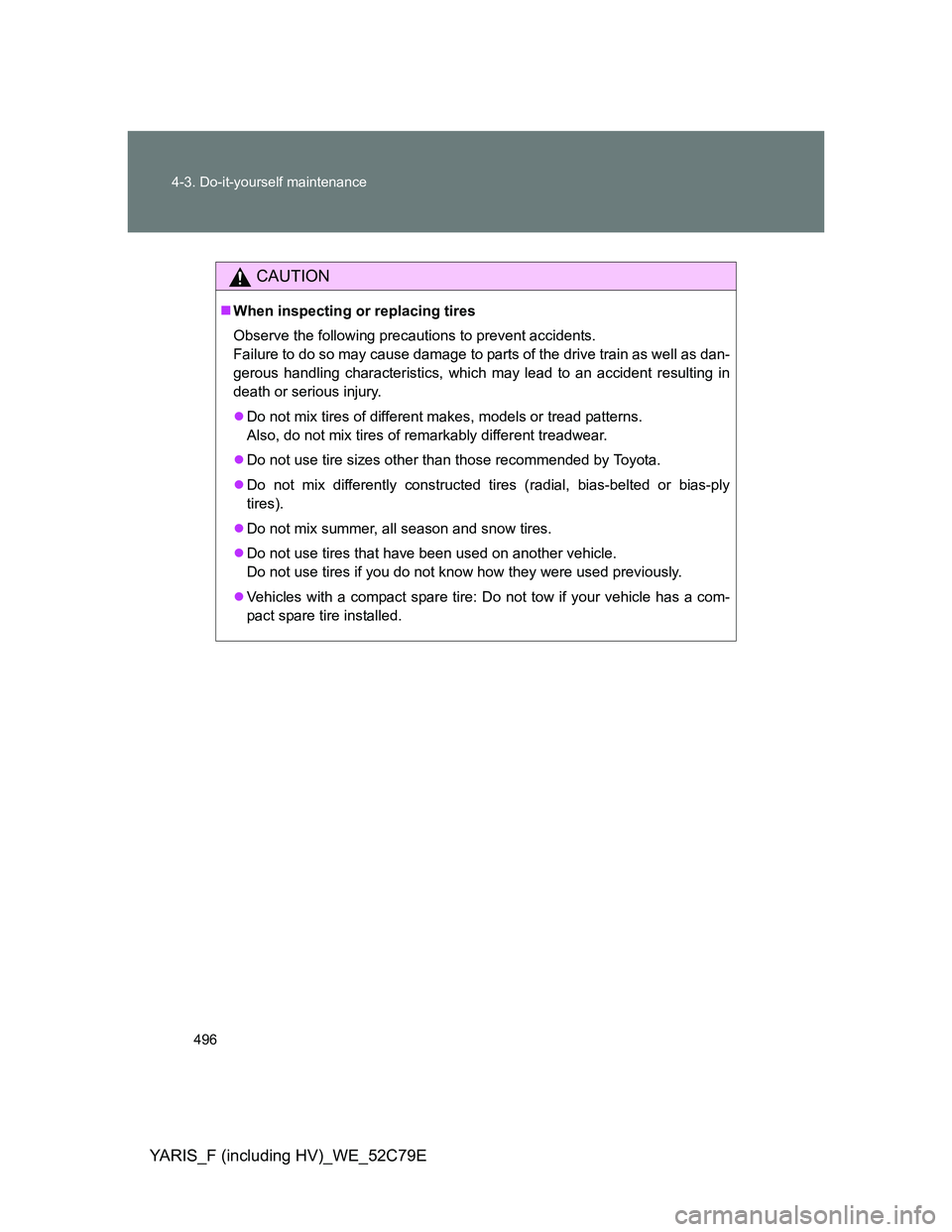
496 4-3. Do-it-yourself maintenance
YARIS_F (including HV)_WE_52C79E
CAUTION
When inspecting or replacing tires
Observe the following precautions to prevent accidents.
Failure to do so may cause damage to parts of the drive train as well as dan-
gerous handling characteristics, which may lead to an accident resulting in
death or serious injury.
Do not mix tires of different makes, models or tread patterns.
Also, do not mix tires of remarkably different treadwear.
Do not use tire sizes other than those recommended by Toyota.
Do not mix differently constructed tires (radial, bias-belted or bias-ply
tires).
Do not mix summer, all season and snow tires.
Do not use tires that have been used on another vehicle.
Do not use tires if you do not know how they were used previously.
Vehicles with a compact spare tire: Do not tow if your vehicle has a com-
pact spare tire installed.
Page 551 of 704
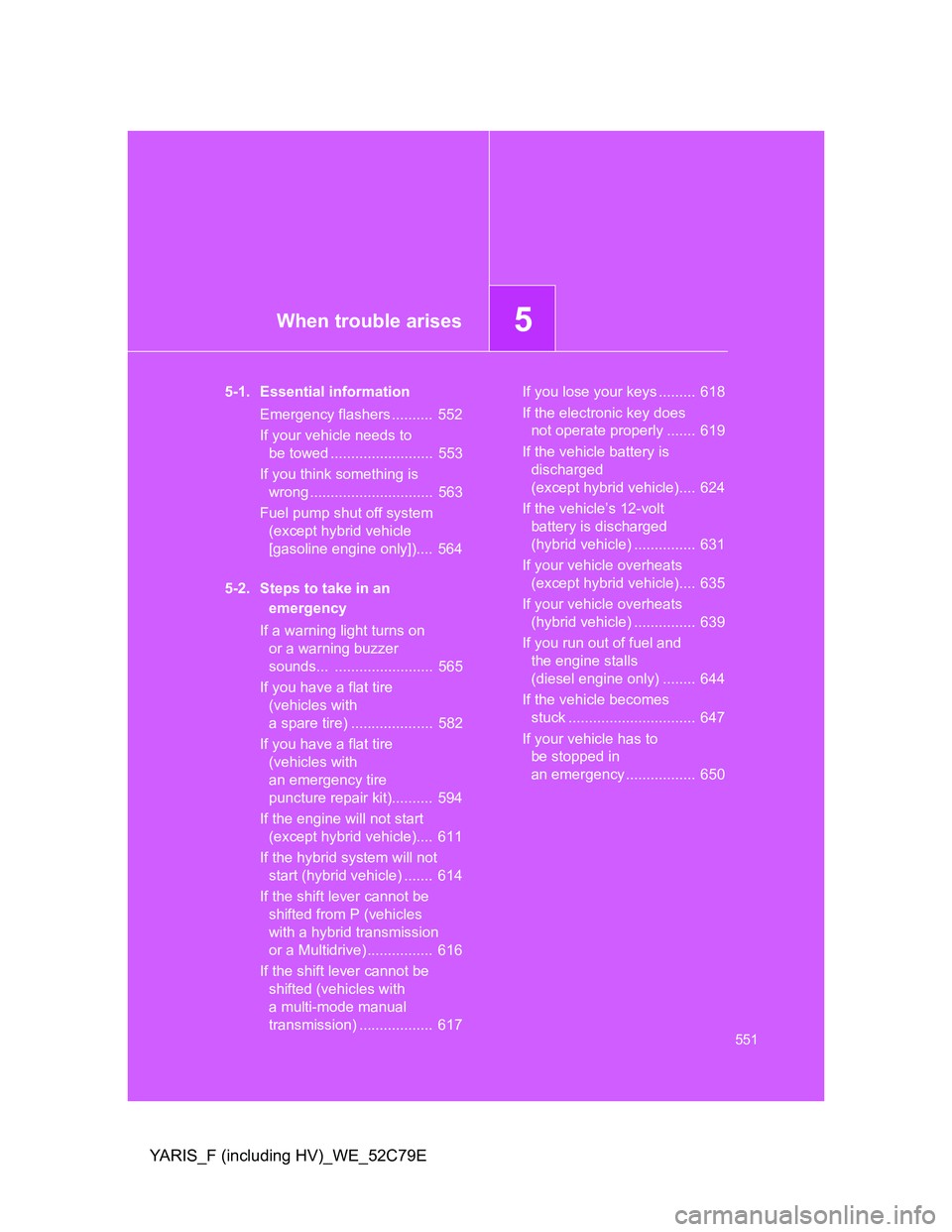
5When trouble arises
551
YARIS_F (including HV)_WE_52C79E
5-1. Essential information
Emergency flashers .......... 552
If your vehicle needs to
be towed ......................... 553
If you think something is
wrong .............................. 563
Fuel pump shut off system
(except hybrid vehicle
[gasoline engine only]).... 564
5-2. Steps to take in an
emergency
If a warning light turns on
or a warning buzzer
sounds... ........................ 565
If you have a flat tire
(vehicles with
a spare tire) .................... 582
If you have a flat tire
(vehicles with
an emergency tire
puncture repair kit).......... 594
If the engine will not start
(except hybrid vehicle).... 611
If the hybrid system will not
start (hybrid vehicle) ....... 614
If the shift lever cannot be
shifted from P (vehicles
with a hybrid transmission
or a Multidrive) ................ 616
If the shift lever cannot be
shifted (vehicles with
a multi-mode manual
transmission) .................. 617If you lose your keys ......... 618
If the electronic key does
not operate properly ....... 619
If the vehicle battery is
discharged
(except hybrid vehicle).... 624
If the vehicle’s 12-volt
battery is discharged
(hybrid vehicle) ............... 631
If your vehicle overheats
(except hybrid vehicle).... 635
If your vehicle overheats
(hybrid vehicle) ............... 639
If you run out of fuel and
the engine stalls
(diesel engine only) ........ 644
If the vehicle becomes
stuck ............................... 647
If your vehicle has to
be stopped in
an emergency ................. 650
Page 558 of 704
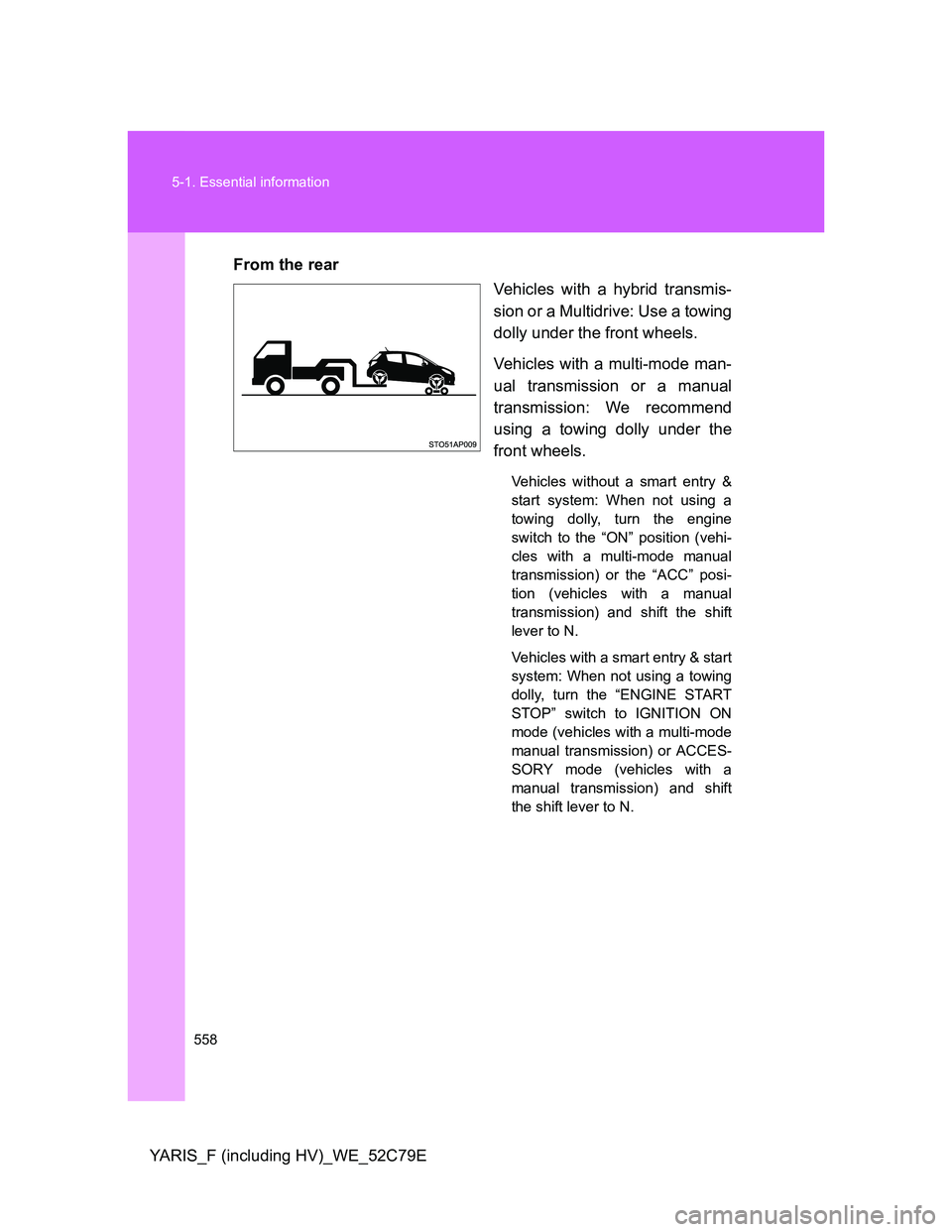
558 5-1. Essential information
YARIS_F (including HV)_WE_52C79EFrom the rear
Vehicles with a hybrid transmis-
sion or a Multidrive: Use a towing
dolly under the front wheels.
Vehicles with a multi-mode man-
ual transmission or a manual
transmission: We recommend
using a towing dolly under the
front wheels.
Vehicles without a smart entry &
start system: When not using a
towing dolly, turn the engine
switch to the “ON” position (vehi-
cles with a multi-mode manual
transmission) or the “ACC” posi-
tion (vehicles with a manual
transmission) and shift the shift
lever to N.
Vehicles with a smart entry & start
system: When not using a towing
dolly, turn the “ENGINE START
STOP” switch to IGNITION ON
mode (vehicles with a multi-mode
manual transmission) or ACCES-
SORY mode (vehicles with a
manual transmission) and shift
the shift lever to N.
Page 567 of 704
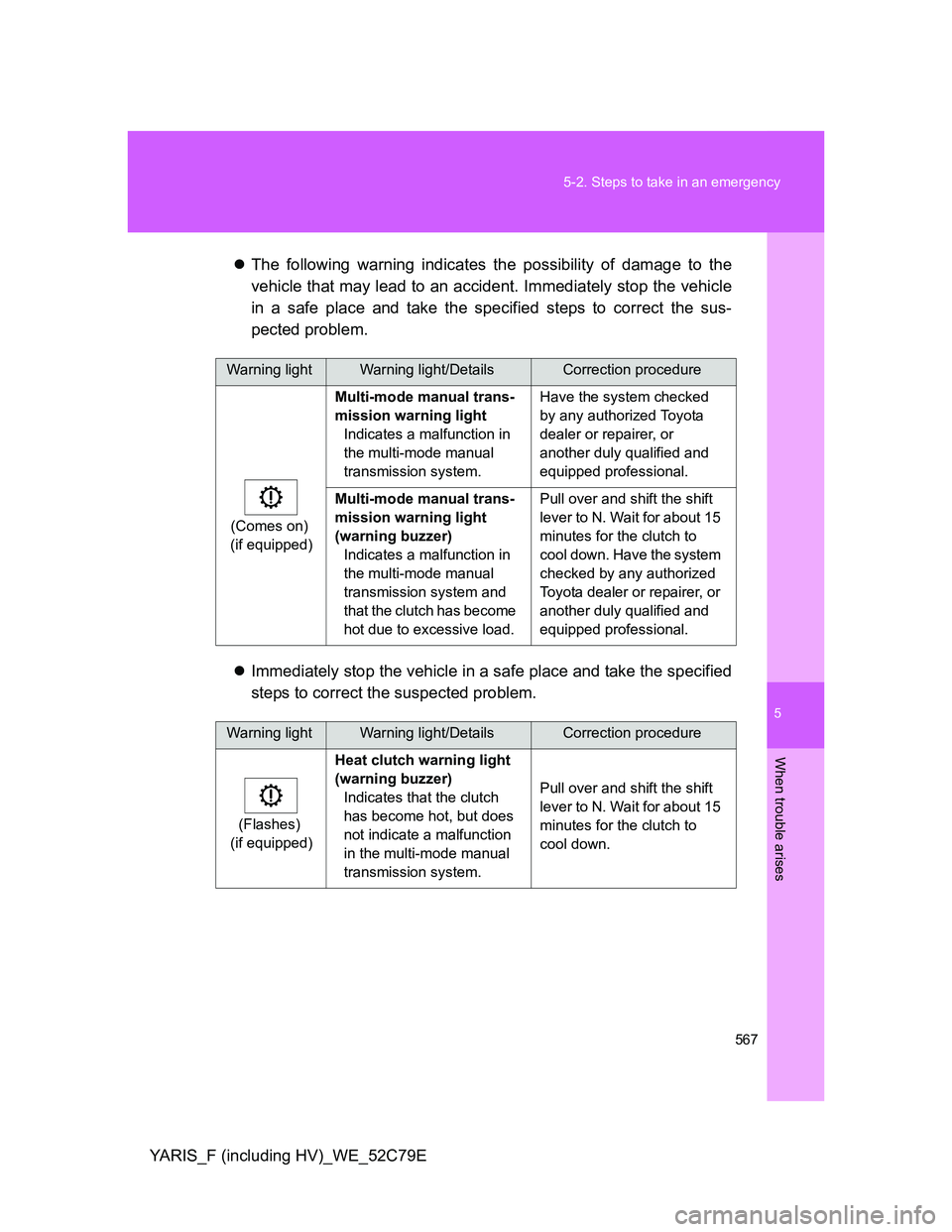
5
567 5-2. Steps to take in an emergency
When trouble arises
YARIS_F (including HV)_WE_52C79EThe following warning indicates the possibility of damage to the
vehicle that may lead to an accident. Immediately stop the vehicle
in a safe place and take the specified steps to correct the sus-
pected problem.
Immediately stop the vehicle in a safe place and take the specified
steps to correct the suspected problem.
Warning lightWarning light/DetailsCorrection procedure
(Comes on)
(if equipped)Multi-mode manual trans-
mission warning light
Indicates a malfunction in
the multi-mode manual
transmission system. Have the system checked
by any authorized Toyota
dealer or repairer, or
another duly qualified and
equipped professional.
Multi-mode manual trans-
mission warning light
(warning buzzer)
Indicates a malfunction in
the multi-mode manual
transmission system and
that the clutch has become
hot due to excessive load. Pull over and shift the shift
lever to N. Wait for about 15
minutes for the clutch to
cool down. Have the system
checked by any authorized
Toyota dealer or repairer, or
another duly qualified and
equipped professional.
Warning lightWarning light/DetailsCorrection procedure
(Flashes)
(if equipped)Heat clutch warning light
(warning buzzer)
Indicates that the clutch
has become hot, but does
not indicate a malfunction
in the multi-mode manual
transmission system.Pull over and shift the shift
lever to N. Wait for about 15
minutes for the clutch to
cool down.